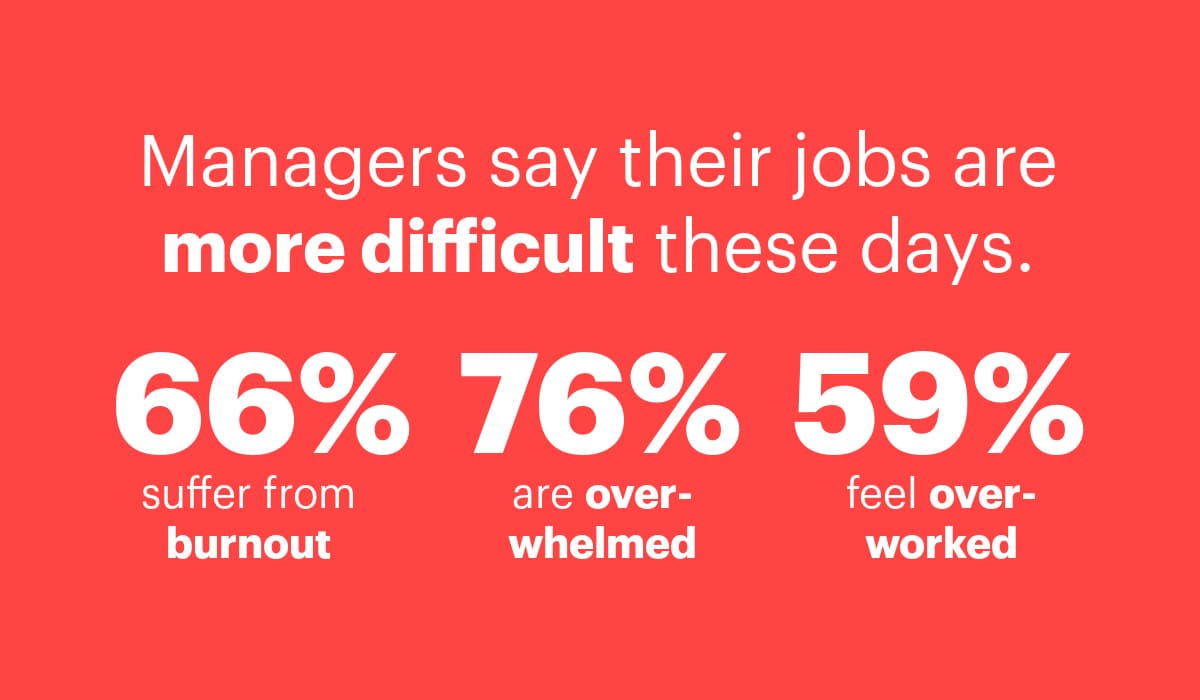Addressing the Risks of Manager Burnout
Manager burnout is on the rise. Learn what companies can do to address the risks of burnout and turnover for managers.

Manager burnout is a problem we ought to talk more about. We hear a lot these days about the “Great Resignation,” but much of the focus is on frontline workers and independent contributors. There’s another group that is equally, if not more, at risk of resignation—managers. Managers have been facing significant stress and dealing with constant change and challenges over the past two years and the situation doesn’t look like it’s going to improve significantly any time soon.
Managers face a triple threat:
CEOs don’t feel confident about meeting or maintaining their managers’ needs. Their boards lack confidence in CEOs as well.
Managers say their jobs are more difficult these days—66% say they suffer from burnout; 76% are overwhelmed; 59% feel overworked.
Employees often say that they hate their managers.

The pandemic and an uptick in remote and hybrid work makes managing harder today than it’s ever been. Things are continually changing and managers are being asked to do more—with less.
Rising pressures cause manager burnout
Expanding on the results of a Humu report on the pressures management is feeling, SHRM says that “managers’ jobs are 10 times harder than before the pandemic”—and they’re about two times more likely than individual contributors to be thinking about leaving their jobs. The report says that the attrition risk for managers in 2021 “was two times higher among managers than individual contributors, and we expect that trend to continue through 2022.”
The cost of turnover is always high, but manager turnover costs are even higher.
This workforce segment is at critical risk of jumping ship leaving their companies in the lurch. What can/should you be doing to minimize the risk?
Why are managers quitting their jobs?
Data shows that managers are leaving their jobs at unprecedented levels. Why? Because they’re feeling embattled, bitter, and not well supported by their organizations.
As executive career coach Kara Dennison writes for Forbes: “Managers must lead entire teams through extraordinary changes and difficulties as workforces and markets are still trying to find stable ground after the past two years.” To do so effectively, they need support from senior leaders and the CEO.
In their 2022 Executive Survey report, Ceridian says: “Despite the important role they play in building organizational strength and agility, our Executive Survey findings show that support for middle managers is lacking.” When asked: “How does your organization support middle managers specifically so they can be successful in their roles?,” the results were fairly dismal. The highest percentage (51%) indicated that they offer management training programs. Percentages offering other types of support all diminished from there.
Support managers say they’re not getting:
Autonomy over their teams: 47%.
Continuous learning options: 47%.
Strengths and weaknesses assessments: 46%.
Access to necessary decision-making data: 45%.
Executive support: 45%.
Training to support employee mental health: 41%.
Two percent of respondents actually indicated that their organization doesn’t offer any type of managerial support at all. How can companies address manager burnout without offering support?
How can companies better support managers to avoid burnout and turnover?
Organizations can do a number of things through their senior leadership team and HR leaders to help ease the burden on managers, reduce burnout, and minimize the chances of turnover among management ranks.
Recognize that managers are at risk. So much attention on turnover among the rank and file has turned the spotlight away from management attrition risk. Put that risk front and center through discussions at the board level and around the senior leadership table.
Check in on middle managers. Ask them how they’re doing—and listen. Gather inputs through one-on-ones, polls, surveys, etc.m Data can be a powerful way to help identify and address the risk of managers quitting jobs.
Identify disengaged managers and take steps to re-engage them. Laura Lee Gentry, Chief People Officer at Enboarder says: “Monitoring for the signs of employee disengagement such as decrease in productivity, lack of participation in company activities, missed deadlines and absenteeism will help businesses identify disengaged managers and supervisors.” From there, she suggests identifying the root cause of the disengagement. “For instance, if a manager is avoiding company outings or missing deadlines, it may be because they feel disconnected from their colleagues or because they’re burnt out. Setting up regular 1:1 meetings and giving them flexibility with their work schedule can help them check in and reconnect with others, and combat the stress and anxiety that can come with leadership roles.”
Prioritize the things that are important to your managers. Research cited here shows the importance of personal and professional development, support, and autonomy. But every organization will be different. Determine your management pain points and prioritize action items to address them.
Normalize the need to talk about stress and stressors. Business consultant Julie Bee, author of the upcoming book The Business Owner’s Guide to Burnout, says: “One of the most powerful leadership tools you can offer your management team is making it okay to say, ‘This stressful thing happened’ or ‘I’m overwhelmed right now.’ If your managers feel like they can bring their burnout to you, and that you’re offering a safe space to talk about burnout and address it, you’ll have a happier, more loyal workforce in the long run.”
Place a focus on the importance of self-care and offer resources and support for managers. This might include workshops, access to online resources, or policies like “no work email after 5:00 p.m., or on weekends.”
The future of manager engagement
Workplace demands have always been a challenge for managers. The sudden shifts in management practices driven by the pandemic, though, have escalated those challenges. The challenges are likely to continue as many companies continue to operate in remote and hybrid ways, and in an environment of economic uncertainty.
Keeping managers engaged and onboard is critical. Taking steps to understand and positively impact the sources of managerial stress and burnout can help you diminish the impact of the Great Resignation on your management ranks, and minimize risks to your organization, your employees, and your customers or clients.
People analytics can help. In fact, our research shows that people analytics can drive as much as a 17% reduction in management turnover. Learn more.
On the Outsmart blog, we write about workforce-related topics like what makes a good manager, how to reduce employee turnover, and employee burnout. We also report on trending topics like the Great Resignation and preparing for a recession, and advise on HR best practices like how to present headcount data to your CEO, metrics every CHRO should track, and connecting people data to business data. But if you really want to know the bread and butter of Visier, read our post about the benefits of people analytics.


